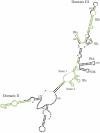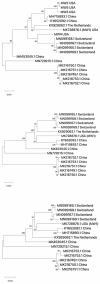Genetic diversity and detection of atypical porcine pestivirus infections
- PMID: 34865057
- PMCID: PMC8760896
- DOI: 10.1093/jas/skab360
Genetic diversity and detection of atypical porcine pestivirus infections
Abstract
Atypical porcine pestivirus (APPV), an RNA virus member of the Flaviviridae family, has been associated with congenital tremor in newborn piglets. Previously reported quantitative polymerase chain reaction (qPCR)-based assays were unable to detect APPV in novel cases of congenital tremor originated from multiple farms from U.S. Midwest (MW). These assays targeted the viral polyprotein coding genes, which were shown to display substantial variation, with sequence identity ranging from 58.2% to 70.7% among 15 global APPV strains. In contrast, the 5'-untranslated region (5' UTR) was found to have a much higher degree of sequence conservation. In order to obtain the complete 5' UTR of the APPV strains originated from MW, the 5' end of the viral cDNA was obtained by using template switching approach followed by amplification and dideoxy sequencing. Eighty one percent of the 5' UTR was identical across 14 global and 5 MW strains with complete or relatively complete 5' UTR. Notably, some of the most highly conserved 5' UTR segments overlapped with potentially important regions of an internal ribosome entry site (IRES), suggesting their functional role in viral protein translation. A newly designed single qPCR assay, targeting 100% conserved 5' UTR regions across 19 strains, was able to detect APPV in samples of well documented cases of congenital tremor which originated from five MW farm sites (1-18 samples/site). As these fully conserved 5' UTR sequences may have functional importance, we expect that assays targeting this region would broadly detect APPV strains that are diverse in space and time.
Keywords: 5′ UTR; APPV; congenital tremor; pestivirus; pig; porcine.
© The Author(s) 2021. Published by Oxford University Press on behalf of the American Society of Animal Science. All rights reserved. For permissions, please e-mail: journals.permissions@oup.com.
Figures


References
-
- Arruda, B. L., Arruda P. H., Magstadt D. R., Schwartz K. J., Dohlman T., Schleining J. A., Patterson A. R., Visek C. A., and Victoria J. G.. . 2016. Identification of a divergent lineage porcine pestivirus in nursing piglets with congenital tremors and reproduction of disease following experimental inoculation. PLoS One. 11:e0150104. doi:10.1371/journal.pone.0150104 - DOI - PMC - PubMed
MeSH terms
LinkOut - more resources
Full Text Sources
Research Materials

